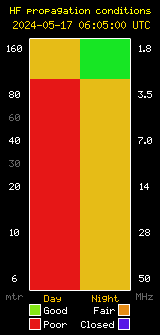 Welcome, and thanks for visiting our website. The Santa Barbara Amateur Radio Club (SBARC) was established in 1920 and has operated continuously ever since. If you are a licensed amateur radio operator and not yet a member, we hope you will consider joining our club. If you are not yet licensed but have an interest in amateur radio, contact us and we’ll help you get started! Better yet come meet our friendly members at one of our monthly club meetings or at the Red Cross Club Station on Saturday mornings.
Welcome, and thanks for visiting our website. The Santa Barbara Amateur Radio Club (SBARC) was established in 1920 and has operated continuously ever since. If you are a licensed amateur radio operator and not yet a member, we hope you will consider joining our club. If you are not yet licensed but have an interest in amateur radio, contact us and we’ll help you get started! Better yet come meet our friendly members at one of our monthly club meetings or at the Red Cross Club Station on Saturday mornings.
Photo caption: Repeaters are the backbone of our local communication systems. SBARC operates numerous repeaters that are open and free to use, including one on Diablo Peak on Santa Cruz Island, which our team accesses with the help of Aspen Helicopters.
ABOUT SBARC
The Santa Barbara Amateur Radio Club is a 501(c)(3) non-profit public benefit corporation. Our public service efforts and emergency communications infrastructure are supported by donations from our members and the community. Your tax deductible contributions help ensure our continued success
WEATHER, INCIDENT & TACTICAL RESOURCES
- SBPD Storm Related Issues
- SBARC Member Weather Stations
- EarthSpot.net ADS-B aircraft tracking from SBARC telecom sites
- Windy.com (iOS, Android apps) rain, wind and forecast models
- MyRadar iOS and Android app for realtime radar (aviators’ choice!)
- National Weather Service Los Angeles Office
- Scientific Forecast Discussion
- AirNow.gov Air Quality Index and more for Santa Barbara.
- S.B County realtime rainfall and waterway data
- Webcams and weather from around the area
- GreatWeather.com local observations and solar data
- SoCal Edison current power outages
- Live Audio streaming public safety scanners in Santa Barbara
EMERGENCY FREQUENCIES
SBARC Designated Emergency Frequencies
- SBARC Main Repeater Output 146.79 / Input 146.19 PL 131.8
- In the event the repeater is not working, use 146.79 SIMPLEX
- Also monitor 146.52 SIMPLEX
We also maintain a list of local frequencies used by first responders and emergency services. These are useful for programming consumer grade scanners. Please click here.













